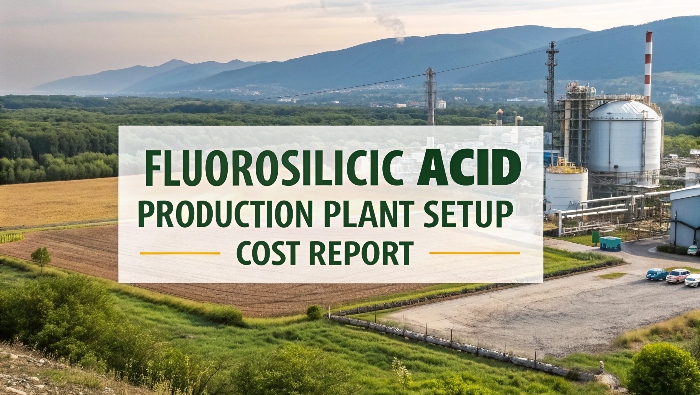Chemicals Industry Today
Fluorosilicic Acid Production Plant Setup Cost Report | Revenue Streams, Expenses, and Financial Insights
Comprehensive Guide to Setting Up a Fluorosilicic Acid Production Plant:
IMARC Group’s Fluorosilicic Acid Production Plant Project Report 2025 offers an in-depth analysis and roadmap for establishing a fluorosilicic acid production plant, covering key project components such as capital investment, operating costs, raw material sourcing, production process, plant layout, and profitability analysis. This detailed report serves as a valuable resource for entrepreneurs, chemical manufacturers, and investors looking to explore the fluorosilicic acid production industry and evaluate project feasibility.

What is Fluorosilicic Acid and How is it Produced?
Fluorosilicic acid (H₂SiF₆) is an inorganic compound primarily produced as a byproduct during the phosphate fertilizer manufacturing process, particularly from wet-process phosphoric acid plants. It appears as a colorless to pale yellow liquid with a strong, pungent odor and is widely used in water fluoridation, metal surface treatment, and as a raw material for producing cryolite and aluminum fluoride.
The manufacturing process typically involves capturing silicon tetrafluoride gas from the reaction between fluorite (CaF₂) and sulfuric acid, which is then absorbed in water to form fluorosilicic acid. The product is further purified, concentrated, and stored under strict safety conditions due to its corrosive nature.
See the Data First: Download Your Sample Report: https://www.imarcgroup.com/fluorosilicic-acid-manufacturing-plant-project-report/requestsample
Key Insights for Fluorosilicic Acid Production Plant Setup-
Detailed Process Flow: Unit Operations and Quality Standards:
• Unit Operations
• Quality Assurance
• Technical Tests
• Raw Material Requirements
The process includes gas scrubbing, condensation, absorption, purification, and concentration stages. Quality control focuses on concentration level (typically 20–25%), impurity removal, and compliance with standards such as ASTM D1179. Raw materials include fluorite, sulfuric acid, and process water. Regular testing ensures product consistency and adherence to safety norms.
Land, Location, and Site Development:
• Selection Criteria
• Site Development
• Environmental Impact
• Land Requirement and Costs
The production plant should be located near phosphate or fluorochemical processing zones for efficient raw material access. Environmental management systems must be in place to handle acidic emissions and effluents. Land requirements depend on production capacity but typically range between 15,000 to 25,000 square feet, including processing, storage, and utility areas.
Plant Layout: Importance and Influencing Factors:
• Designated Zones
• Layout Factors
• Operational Benefits
The layout should separate raw material storage, gas absorption, reaction, and storage areas to ensure safety and efficient workflow. Proper ventilation and corrosion-resistant materials are essential for operational safety and equipment longevity.
Plant Machinery: Requirements and Costs:
• Essential Equipment
• Cost Considerations
• Supplier Support
Core machinery includes absorption towers, scrubbers, reactors, condensers, pumps, storage tanks, and corrosion-resistant piping systems. Equipment cost depends on automation level and plant capacity. Reputed suppliers provide installation assistance, safety training, and after-sales support to ensure smooth operations.
Request a Customized Project Report for Your Capacity: https://www.imarcgroup.com/request?type=report&id=11046&flag=C
Raw Materials: Procurement and Costs:
• Feedstock Options
• Procurement Strategy
• Cost Factors
The main feedstocks are fluorite (CaF₂), sulfuric acid (H₂SO₄), and water. Procurement should be from reliable chemical suppliers ensuring high purity levels to reduce contamination during production. Feedstock prices can fluctuate based on regional supply and energy costs, influencing overall production expenses.
Packaging: Requirements and Suppliers:
• Packaging Materials
• Procurement Needs
• Cost and Compliance
Fluorosilicic acid is packaged in corrosion-resistant containers such as HDPE drums or PVC-lined tanks. Packaging ensures safe transport and prevents leakage or vapor emission. Compliance with hazardous material handling regulations (UN 1778) is mandatory.
Other Requirements and Costs:
• Transportation
• Utilities
• Energy and Water
• Human Resources
Transportation logistics should comply with chemical safety standards. Utilities like electricity, water, and compressed air are essential for continuous operation. Trained personnel are needed to handle chemical processes, maintenance, and safety operations.
Project Economics: Costs and Profitability-
• Capital Investment
• Operating Costs
• Revenue and Margins
The fluorosilicic acid production plant setup cost includes expenses for land, machinery, safety systems, and infrastructure. Operating costs cover raw materials, utilities, labor, and maintenance. Given the compound’s diverse applications in water treatment and chemical manufacturing, the project offers steady profitability and long-term growth potential.
Financial Analysis: Investment Returns and Risk Assessment-
• Performance Metrics
• Return on Investment
• Risk Factors
Key financial indicators such as NPV, IRR, and ROI determine project viability. Risk factors include volatility in fluorite prices, regulatory changes, and waste disposal management. Adopting sustainable production practices and energy-efficient technologies enhances profitability and compliance.
Other Analysis Covered: Market Trends and Strategic Insights-
• Market Trends
• Segmentation
• Regulatory Environment
• Case Studies
The global fluorosilicic acid market is witnessing strong growth, driven by increasing demand from the water treatment, aluminum, and glass industries. Rising environmental regulations and the shift toward safer fluorochemical management are also shaping industry trends.
Conclusion:
Establishing a fluorosilicic acid production plant represents a lucrative investment opportunity backed by consistent industrial demand and evolving applications. With careful attention to plant design, safety protocols, and regulatory compliance, investors can achieve strong returns and ensure sustainable operations.
You Might Read Also Our Newsletter About "Business Plan 2025-2026": https://www.linkedin.com/newsletters/business-plan-7388491075415470080/
About Us:
IMARC is a global market research company offering comprehensive services to support businesses at every stage of growth, including market entry, competitive intelligence, procurement research, regulatory approvals, factory setup, company incorporation, and recruitment. Specializing in factory setup solutions, we provide detailed financial cost modelling to assess the feasibility and financial viability of establishing new manufacturing plants globally. Our models cover capital expenditure (CAPEX) for land acquisition, infrastructure, and equipment installation while also evaluating factory layout and design's impact on operational efficiency, energy use, and productivity. Our holistic approach offers valuable insights into industry trends, competitor strategies, and emerging technologies, enabling businesses to optimize operations, control costs, and drive long-term growth.
Contact Us:
IMARC Group
134 N 4th St. Brooklyn, NY 11249, USA
Email: sales@imarcgroup.com
Tel No:(D) +91 120 433 0800
United States: (+1-201971-6302)
Share on Social Media



Other Industry News
Ready to start publishing
Sign Up today!








